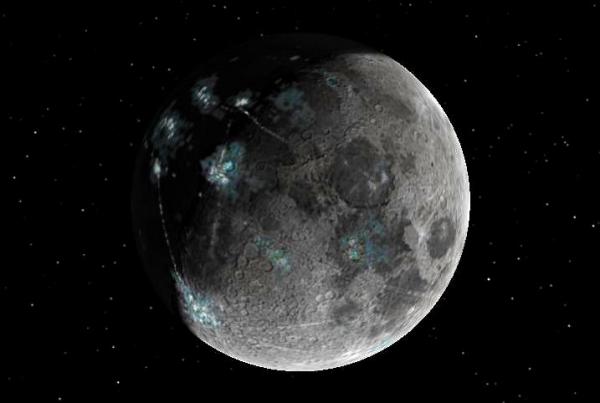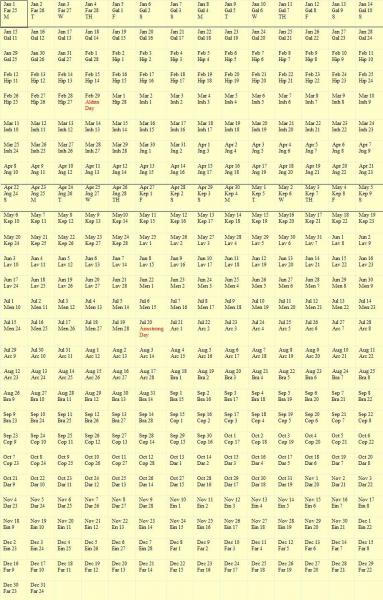BY LETTER
Tranquility Calendar, The
A calendar first used on Earth's Moon and then adopted throughout the Terragen Sphere | |
 Image from Steve Bowers | |
| The Moon in the Late Interplanetary Age; soon this small world's population would increase rapidly due to the influx of refugees from Earth | |
After the Earth was evacuated in the aftermath of the Technocalypse, most refugees adopted the Lunar Calendar (also known as the Tranquility Calendar) which was already widely used in the colonies of the Solar System. For some centuries after the Great Expulsion many refugees continued to use the old months while adopting the new yearly dates; but by the time of the First Federation the new Lunar Months has also been widely adopted. Today most timekeeping software is capable of displaying the date according to the After Tranquility system; because of relativistic effects (discussed here) this date can generally only be regarded as approximate. The Standard Year in the Tranquility Calendar is the same as that for Old Earth, and has also been adopted as a standard measurement in locations throughout the Terragen Sphere, though it is by no means the most common calendar system.
The Tranquility Calendar
The Tranquility Calendar is a calendar that had its roots in science. Its center date in history is called Moon Landing Day. According to tradition, the actual center point in time was the exact moment the word 'tranquility' was mentioned in the famous quote: Houston, Tranquility Base Here. The Eagle Has Landed. These were the first words ever spoken by a human from the surface of another world. Moon Landing Day was not counted as part of any month or year; it had 20 hours, 18 minutes, and 1.2 seconds Before Tranquility (B.T.), and 3 hours, 41 minutes, and 58.8 seconds After Tranquility (A.T). The Gregorian equivalent of Moon Landing Day was July 20, 1969 c.e..The Tranquility Calendar is logically structured so that days of the week do not vary from month to month, and there are no changes in calendar structure based on year.
Months
Because the Tranquility calendar was designed as a calendar for science, the 13 months were named after scientists. The thirteen individuals who are commemorated by the calendar were all (of course) born on Earth, and despite the large amount of historical data lost during the Technocalypse, much information was preserved on Luna about almost all of them. In order, the months are named for the following individuals: Archimedes, Brahe,Copernicus, Charles Darwin, Einstein, Faraday, Galileo, Hippocrates, Imhotep, Jung, Kepler, Lavoisier, and Mendel. Most versions of the calendar have a minimal summary of the person the month is named after, as follows:Archimedes (circa 287 to 212 B.C.), Greek mathematician and inventor
Tycho Brahe (1546 to 1601), Danish astronomer
Nicolaus Copernicus (1473 to 1543), Polish astronomer
Charles Darwin (1809 to 1882), English naturalist
Albert Einstein (1879 to 1955), American (German-born) theoretical physicist
Michael Faraday (1791 to 1867), English chemist and physicist
Galileo Galilei (1564 to 1642), Italian astronomer and physicist
Hippocrates (circa 460 to circa 377 B.C.), Greek physician
Imhotep (circa 2980 to 2950 B.C.), Egyptian physician and sage
Carl Jung (1876 to 1961), Swiss psychologist and psychiatrist
Johannes Kepler (1571 to 1630), German astronomer
Antoine Lavoisier (1743 to 1794), French chemist
Gregor Mendel (1822 to 1884), Austrian botanist.
(Historical Note: due to the infowars and deletionism of the Technocalypse and Dark Ages little reliable information survived about Hippocrates or Imhotep, even on Luna, when the Tranquility Calendar came to be widely published in First Federation times, though records have been found or reconstructed in the time since.)
To facilitate record keeping, the months proceed in alphabetical order. The first day of each year is the first day of Archimedes (July 21 on the Gregorian calendar). The last day of each Tranquility year is called Armstrong Day. Named for the first human to step on the moon, Armstrong Day celebrates the anniversary of Moon Landing Day. Thus July 20, 1970 c.e., was the Gregorian equivalent of Armstrong Day, 1 A.T., and July 20, 1989 c.e., was Armstrong Day, 20 A.T.
Days
The days, in order, are Friday, Saturday, Sunday, Monday, Tuesday, Wednesday, Thursday. Each month has exactly 28 days. The first of each month is always a Friday. The twenty-eighth of each month is always a Thursday. There are 365 days in each year, except for leap years, in which there are 366 days.Thirteen month of 28 days each totals 364 days. Each year on the anniversary of Moon Landing Day there is a special day of the year called Armstrong Day. This day has no day of the week. It falls between Mendel 28 and Archimedes 1 of the following year. Finally, the Tranquility calendar equivalent of leap day is called Aldrin Day. This day also has no day of the week. Named for Armstrong's fellow moon walker, Aldrin Day occurs every four years, with some exceptions. The exceptions are the leap days in every 400 years that are dropped to keep the calendar astronomically precise. Aldrin Day falls between the twenty-seventh and twenty-eighth of Hippocrates (February 29).
The Tranquility Calendar mapped to the Gregorian | |
 Image from Steve Bowers | |
| Click for Larger Image | |
Related Articles
- AT (After Tranquility)
- BT (Before Tranquility)
- Calendars and Timekeeping
- Light-year - Text by M. Alan Kazlev
The distance light travels in one standard or metric (Earth) year, viz. 9.46x1012 km. Standard unit of measurement. It is equal to 6.323x104 astronomical units (AU) or 0.307 parsecs. - Luna
- Standard Year
- To'ul'h Calendar
- Year
Appears in Topics
Development Notes
Text by Jeff Siggins, adapted by Steve Bowers
Initially published on 09 September 2008.
added minor note that the calendar is " by no means the most common calendar system" for clarification
December 2022
Initially published on 09 September 2008.
added minor note that the calendar is " by no means the most common calendar system" for clarification
December 2022
Additional Information






